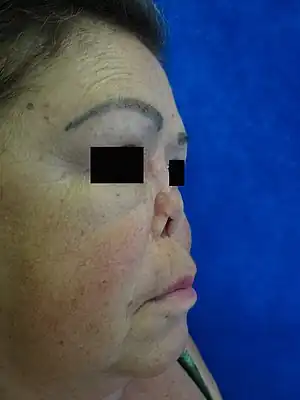Saddle nose
| Saddle nose | |
|---|---|
 | |
| Lateral view of the face with a saddle nose deformity far up on the bridge due to granulomatosis with polyangiitis from using a nasal prosthesis | |
| Specialty | Plastic surgery |
Saddle nose is a condition associated with nasal trauma, congenital syphilis, relapsing polychondritis, granulomatosis with polyangiitis, cocaine abuse, and leprosy, among other conditions.[1] The most common cause is nasal trauma. It is characterized by a loss of height of the nose, because of the collapse of the bridge. The depressed nasal dorsum may involve bony, cartilaginous, or both bony and cartilaginous components of the nasal dorsum.
It can usually be corrected with augmentation rhinoplasty[2] by filling the dorsum of the nose with cartilage, bone or synthetic implant. If the depression is only cartilaginous, cartilage is taken from the nasal septum or auricle and laid in single or multiple layers. If deformity involves both cartilage and bone, cancellous bone from iliac crest is the best replacement. Autografts are preferred over allografts. Saddle deformity can also be corrected by synthetic implants of teflon or silicon, but they are likely to be extruded.[3]
 Saddle nose in congenital syphilis
Saddle nose in congenital syphilis.png.webp) Saddle nose in congenital syphilis
Saddle nose in congenital syphilis
See also
References
- ↑ Schreiber, BE; Twigg, S; Marais, J; Keat, AC (April–May 2014). "Saddle-nose deformities in the rheumatology clinic". Ear, Nose, & Throat Journal (Review). 93 (4–5): E45-7. PMID 24817241.
- ↑ Saddle Nose Rhinoplasty at eMedicine
- ↑ Oto-Rhino-Laryngologie in Klinik und Praxis : in 3 Bänden. 2, Nase, Nasennebenhöhlen, Gesicht, Mundhöhle und Pharynx, Kopfspeicheldrüsen. Jan Helms, Ernst Kastenbauer, Hans Heinz Naumann. Stuttgart: Thieme. 1992. ISBN 3-13-676601-6. OCLC 630306976. Archived from the original on 2023-07-02. Retrieved 2022-11-04.
{{cite book}}: CS1 maint: others (link)
External links
| Classification |
|---|